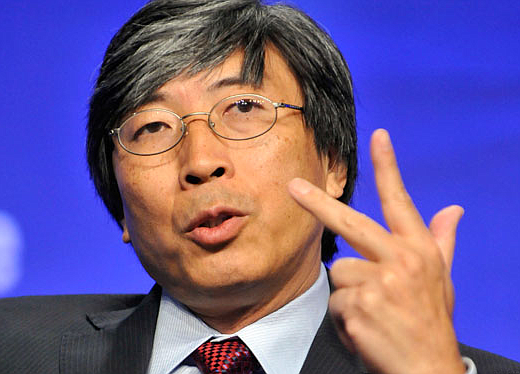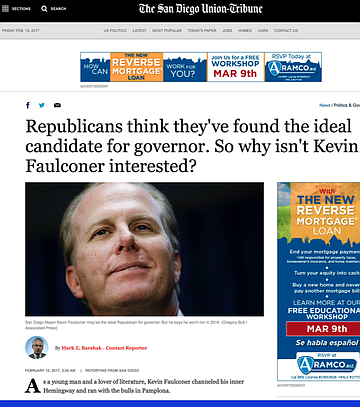 Facebook
Facebook
 X
X
 Instagram
Instagram
 TikTok
TikTok
 Youtube
Youtube

Wall Street analysts at NobleCon13, an investor conference run by Noble Capital Markets, were recently presented with a fundamental truth about the newspaper business, but it wasn’t good news for readers of the San Diego Union-Tribune and the string of other papers owned by Chicago-based tronc, Inc.

"Over all, print is attriting," tronc chief executive Justin C. Dearborn told the January 30 gathering.
"We are going to attrit with the industry."
Those using Merriam-Webster to decipher Dearborn's corporate-speak discovered the meaning of that transitive verb to be, "a reduction in numbers usually as a result of resignation, retirement, or death."
Adds Investopedia, "This type of reduction in staff is one way a company can decrease labor costs: the company simply waits for its employees to leave and freezes hiring. Such a method contrasts with more severe labor-reduction techniques, such as mass layoffs. Waiting for attrition naturally is usually better for company morale; however, it can also have a negative impact on the employees that remain if the duties from the eliminated positions are transferred to them with no pay increase. It can also limit promotions within the company if these jobs are eliminated, which can result in further attrition and turnover.”
Though attriting may not be the best prescription for the future of the newspaper business, Dearborn turned upbeat as he unveiled tronc's new mission statement: "Creating a billion dollar online media network."

Though Dearborn didn't elaborate, making that happen is said to be in the hands of L.A. biotech billionaire Patrick Soon-Shiong — vice chairman of the company with 16 percent of its stock — who is said to be developing an automated way to replace attriting reporters and editors.
Meanwhile, more and more of the Union-Tribune’s reportage is being handed off to scribes at the paper's big sister, the Los Angeles Times, which also prints the San Diego daily at a giant plant in downtown L.A.

"Republicans think they've found the ideal candidate for governor. So why isn't Kevin Faulconer interested?" asks the headline of a story about the future of San Diego's mayor posted by the U-T February 10.
The byline belongs to reporter Mark Z. Barabak, a longtime veteran of the L.A. Times.
"As a young man and a lover of literature, Kevin Faulconer channeled his inner Hemingway and ran with the bulls in Pamplona," says the story.
The Faulconer profile is notable for omitting such high-profile mayoral controversies as this year's Chargers exodus to L.A., while reporting that Faulconer "carried a substantial chunk of the Latino vote running against a Latina opponent," without mentioning the mayor's fat campaign funding advantage.
Many of the L.A.-written stories are among the most popular run by the U-T: a February 8 account by Times metro reporter Hailey Branson-Potts about a foster father in Azusa who adopts terminally ill children was an especially big draw.


Wall Street analysts at NobleCon13, an investor conference run by Noble Capital Markets, were recently presented with a fundamental truth about the newspaper business, but it wasn’t good news for readers of the San Diego Union-Tribune and the string of other papers owned by Chicago-based tronc, Inc.

"Over all, print is attriting," tronc chief executive Justin C. Dearborn told the January 30 gathering.
"We are going to attrit with the industry."
Those using Merriam-Webster to decipher Dearborn's corporate-speak discovered the meaning of that transitive verb to be, "a reduction in numbers usually as a result of resignation, retirement, or death."
Adds Investopedia, "This type of reduction in staff is one way a company can decrease labor costs: the company simply waits for its employees to leave and freezes hiring. Such a method contrasts with more severe labor-reduction techniques, such as mass layoffs. Waiting for attrition naturally is usually better for company morale; however, it can also have a negative impact on the employees that remain if the duties from the eliminated positions are transferred to them with no pay increase. It can also limit promotions within the company if these jobs are eliminated, which can result in further attrition and turnover.”
Though attriting may not be the best prescription for the future of the newspaper business, Dearborn turned upbeat as he unveiled tronc's new mission statement: "Creating a billion dollar online media network."

Though Dearborn didn't elaborate, making that happen is said to be in the hands of L.A. biotech billionaire Patrick Soon-Shiong — vice chairman of the company with 16 percent of its stock — who is said to be developing an automated way to replace attriting reporters and editors.
Meanwhile, more and more of the Union-Tribune’s reportage is being handed off to scribes at the paper's big sister, the Los Angeles Times, which also prints the San Diego daily at a giant plant in downtown L.A.

"Republicans think they've found the ideal candidate for governor. So why isn't Kevin Faulconer interested?" asks the headline of a story about the future of San Diego's mayor posted by the U-T February 10.
The byline belongs to reporter Mark Z. Barabak, a longtime veteran of the L.A. Times.
"As a young man and a lover of literature, Kevin Faulconer channeled his inner Hemingway and ran with the bulls in Pamplona," says the story.
The Faulconer profile is notable for omitting such high-profile mayoral controversies as this year's Chargers exodus to L.A., while reporting that Faulconer "carried a substantial chunk of the Latino vote running against a Latina opponent," without mentioning the mayor's fat campaign funding advantage.
Many of the L.A.-written stories are among the most popular run by the U-T: a February 8 account by Times metro reporter Hailey Branson-Potts about a foster father in Azusa who adopts terminally ill children was an especially big draw.
Comments